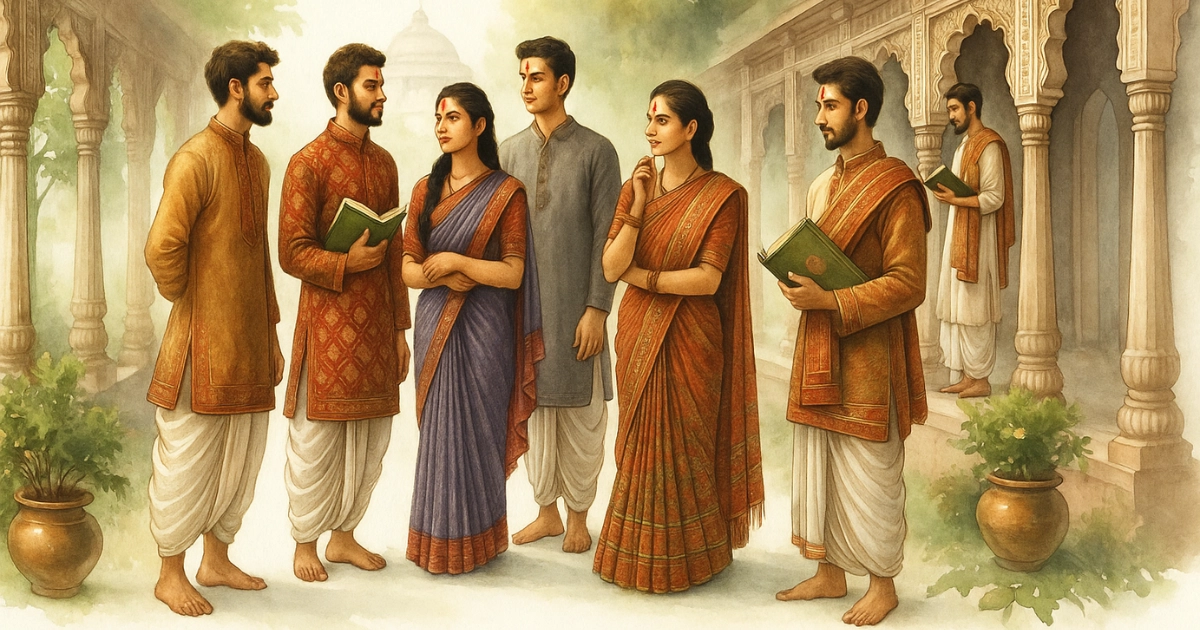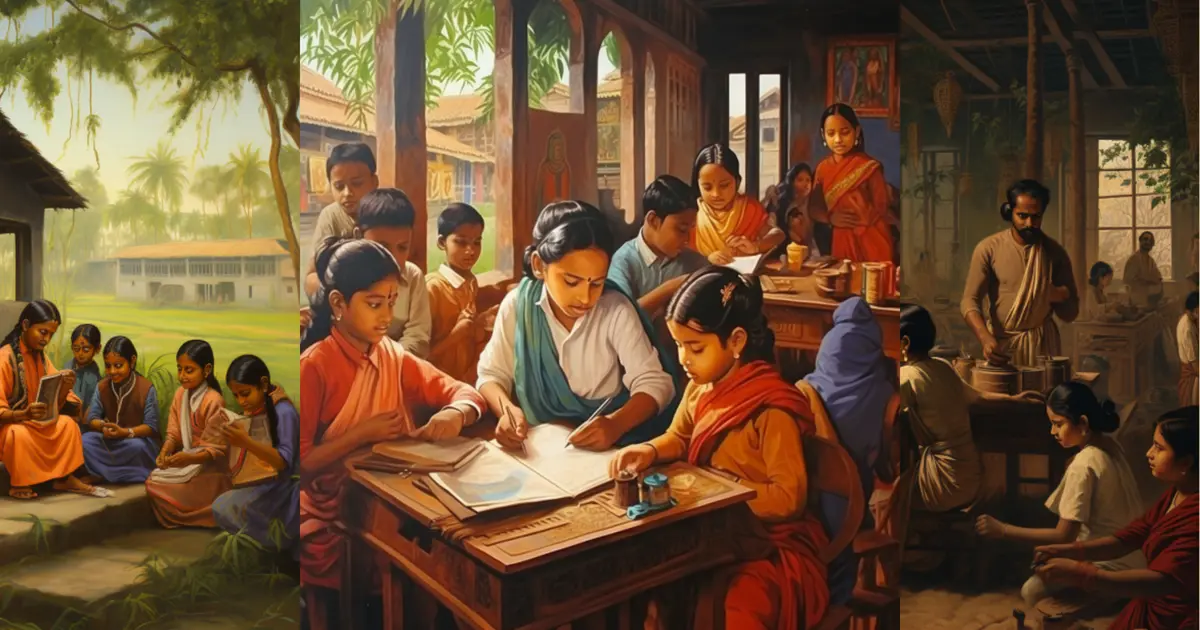If we want to be the architect of our true future, we must understand our past. It may be that while exploring the past, we may come by some seed-ideas which are true for all times. If that happens, those ideas may give us some direction and guidance in our current educational planning.
Śrī Ram Swarup
Where Are We Today
Let us take a brief moment to look around ourselves. On one hand, we find the globalized world plunging deeper into the crisis of individual meaninglessness and collective chaos with each passing day. Modern day education, a continuation of the colonial legacy and a product of a fractured paradigm of consciousness, fails to provide means for deeper emotional and spiritual fulfillment of the individual.
On the other hand, even today we see hordes of children marching into the age-old Vaidika gurukulas of this land, to partake of knowledge that is not only sacred but has endured centuries of targeted destruction. We find ourselves drawn to the discipline, joy, and multi-faceted intelligence that they embody.
Today, experiential learning methods and principles emergent from dhārmika and yaugika traditions are also spreading across the globe, validated by research in the educational sciences, but shred inevitably of their sacred core.
In another parallel yet interconnected development, gurukulas that seek to preserve the tradition but innovate to deal with contemporary challenges are growing both in success and demand. These institutions draw from the same vitality and vision of the great ṛṣi paramparā of Bhārata.
In the same vein, we are witnessing and becoming increasingly a part of the nationwide movement to introduce “Indian Knowledge Systems” in higher education. While many of us are growing acquainted with the theoretical underpinnings of this civilizational knowledge bank, we find ourselves conflicted in comprehending its core vision; and thereby, the means for its effective implementation.
Most of us agree that the present system of education has done little to create whole, integrated individuals, and is not likely to help any future realisation of the true potential of humanity. A coherent solution cannot emerge from a paradigm that is already the root cause of the challenges we face. Therefore, the answers lie in an entirely alternative, wholesome and time-tested paradigm of education. One that is closer home, that continues to thrive on this very soil.
At this juncture, let us pause and ask ourselves:
- Why and how have traditional learning institutions endured?
- What does the renascent Indic education model guided by civilizational learning principles have to offer to us as educators?
- What is the larger vision underlying the Indian Knowledge Systems?
- How might we comprehend and utilize this vision for the transformation of our next generation?
In this article, we will delve into the Bhāratīya vision of why and how people learn, the core pedagogical principles as practiced by an unbroken paramparā of ṛṣis and ācāryas, and why re-awakening a civilizational identity and ‘way of seeing’ is critical in shaping future generations who are capable of forging harmonious national and global futures.
For we must always remember, that as teachers and educators, as the bearers of perhaps the most ancient tradition there is, our role and duty represents the single most important thing that will determine the future of humanity and life in this world.
Gleaning From the Past for a Glorious Future
When we speak of the ṛṣis of Bhārata, we may understand them as highly advanced, subjective scientists. Theirs was a humble, directed and deeply reflective quest into the truth of both the cosmos and human nature, culminating in a continued discovery of mechanisms to abide in ‘ātmasukha’, an infinite pool of happiness and knowledge that lies at our very core. To them, transmitting this wisdom to their students meant the shaping of not just the child’s outer personality, but offering space for the expansion of his innermost consciousness.
As this guru-śiṣya paramparā took shape, critical discoveries were made across material and moral, physical and spiritual dimensions and in disciplines ranging from logic and linguistics to mathematics and applied medicine.
Over time, the traditional systems of transmission of learning developed into the great ancient universities that we know of, i.e. Takṣaśilā and Nālandā, and the many temple-universities of the south. Chinese travel accounts describe the love of learning in India and how it emerged from the seeds of curiosity, naturally planted in childhood.
As we scourge through, it is in the works of great thinkers like Śrī Dharampal that we discover many such essential tidbits of what education in Bhārata once looked like. However, our purpose here is a deep dive into the pedagogical principles that truly set apart this ancient model of education. Even then, we must caution that this piece is only a humble introduction to this vast subject.
Here, we draw our explorations and conviction from both the timeless guru paramparā and contemporary seers who have labored to revive the civilizational vision of education for all of us.
One such seer, Śrī Ram Swarup states -
If we regard man as a physical entity, our approach to education would be of one kind: if we regard man as a mental being, our approach would be of a different kind. But if we regard man as a spiritual being, our educational formulations are bound to be different.
While every individual is a composite of these different layers, emphasis on a particular dimension colors the lens through which we look at the world. The seers of Bhārata viewed the human being as a soul in evolution, each with unique physical, mental, emotional and intellectual characteristics, yet molded in the same consciousness as that of the manifest world and the larger unmanifest universe that he is a part of. Education was thus sacred. It was essentially a yajña, a service unto something greater than ourselves.
It is this core principle that lends Indian education its unique, integrative character. It recognizes the life journeys of every individual while helping them grow, expand and serve the interconnected whole that they belong to. It aspired for the child to blossom into a complete human being and therefore developed various systems such as that of Yoga and Āyurveda to nurture the faculties of the child and enable him to come home to his true potential.
In keeping with this principle, one of the core goals of Indic education was to strengthen the body and mind, senses and vitality such that the individual enjoys a full, vigorous, joyful and healthy life built on the foundations of an able body, a strong character and will and a mind that is both powerful and humble, pure and deep in its expanse. This resolute seeking is echoed in the prayers of several mantras found in Vaidika Sūktas and the Upaniṣads.
Contemporary research tells us that students process information more deeply when they adopt mastery goals that encourage them to aspire towards a higher objective. It also speaks of inter-disciplinarity and the unified theory of knowledge, where all subjects of learning in essence are one.
Here, we hark back to the second aim of Indic learning where the seers sought not to provide only bits of information on seemingly unrelated subjects but to mould the processes of the mind itself.
They were focused on building a centered, multi-disciplinary mind that would serve the individual all his life.
Modern MRI scans that study how the brain works and learns, confirm many insights of the Yaugika traditions. The brain is not comfortable learning in bits. After a period of formal learning, it requires a gap where it assimilates and integrates what it has learnt. At this stage, information moves from temporary memory to permanent memory, thereby becoming our own. The third phase where we express our learning in our own words is re-expression. At this point, learning becomes a lived experience.
After a study session with the teacher, the students would sit by themselves and contemplate upon what was learnt, question it, consider it in various angles and draw their own conclusion. Once ready, they would present what they had found and discuss. The ancient sages used this three-step process of absorption, assimilation and re-expression to the fullest.
However, the teachers of yore had an advantage. They would run these three-step cycles with a subject for a whole day, sometimes a week or even a month. This led to maximum absorption, depth, assimilation and eventually - mastery or a complete cognitive shift.
In his book on Śrī Aurobindo's integral education, Śrī Sraddhalu Ranade writes -
This condition of immersion is one of the most powerful means of awakening knowledge as a living force of experience.
How might we apply this principle in the limited environs of today? One strategy would be to teach for a while, and then provide a few silent minutes to the students to assimilate and prepare, after which they discuss the ideas in their own words.
Finally, the third aim upon which anchors everything else: a restful state of mind. A mind that is able to conquer its own tendencies such as inattention, distraction and confusion. They devised seemingly simple yet profound and effective mechanisms such as prāṇāyāma and dhyāna, that are available to us even today. For instance, somewhere in Gujarat, children chanted ‘aum’ for two minutes in breaks between two consecutive periods. This improved assimilative powers dramatically. This is because the sound of aum is known to create a vibration of peace and harmony that allows the mind to relax and integrate.
Another example is where a mind in harmony and an inter-disciplinary immersion meet: when students spend time in the midst of nature, observing the growth of plants and the behavior of animals and watching sunrises and sunsets, they not only reflect upon the science that drives such phenomena but also experience the cycles of the universe as an intimate part of their own selves.
Śrī Aurobindo's Three Pedagogical Principles
Another contemporary seer we will draw our insights from, is Śrī Aurobindo. He condenses the entire philosophy of education into three terse sūtras:
1. Nothing can be taught
This principle emerges from what we had seen earlier - that each child is a soul in evolution. Therefore, all that is to be known is present in him as a potent, divine seed. It is our job to facilitate its flowering, by nourishing the student's inherent curiosity and his own innate abilities.
Teaching becomes as much a process of discovery and learning, of enabling knowledge, ideals and values as an experience.
Civilizationally, one of the ways that comes to us is story-telling and leading by example. Children learn best from examples of idols who have lived their ideals. Why are Śrī Rāma and Śrī Kṛṣṇa ever so relevant and their stories so relatable? Because we experience their courage and pain as our own.
The ancient sages formulated a three-fold pedagogy appealing to different kinds of minds, all aimed at facilitating contemplation upon the deeper knowing seated within.
- Prabhu sammita (like the Lord)- the teachings of the śāstras such as, "satyam vāda (speak the truth), dharmam cāra (walk the path of dharma), are designed to hit straight at the intellectual and contemplative mind and bring it into a state of deep silence.
- Mitra sammita (like a friend)- The itihāsa-purāṇas speak to all of us like a friend does. Prahlāda's devotion, the resilience of the Pāṇḍavas, the downfall of Rāvaṇa - each story evokes curiosity and brings wonder every time we listen to it. They contain ideals that the mind must anchor on.
- Kāntā sammita (like a lover)- Designed for the emotive and unrestrained mind, the kāvyas (works of literature and poetry) utilize the navarasas to evoke deep transformative experiences in the listener. For example, witnessing Rāma's compassion and valour unfold in a story or a theater play, sows the seed of dharma in our hearts without us even being aware.
2. The mind must be consulted in its own growth
Also emergent from the insight that a child is a soul in evolution, it recognizes that each individual has a unique purpose and therefore a unique temperament or svabhāva.
In the exposition of the previous principle we learnt of the tri-sammitas. The same methods are applicable here too. With some children, emotive reasoning may work while with some others, they may have to experience the consequences of a mistake before they understand.
Some children may learn better visually, while others are kinesthetic. And then there is also the composition of the triguṇas (sattva, rajas, tamas) that play a critical role. For example, the sāttvika mind observes keenly and learns on his own.
The ultimate goal of education in the Indic system is also eliminating the inertia of tamas, cultivating a stable base for the activity of rajas and awakening the light of sattva.
Each individual has four core aspirations, one of which may drive him more than others, namely:
- Knowledge - to learn, know and share
- Force - to lead and protect
- Wealth - to seek abundance for the individual and the collective
- Service and Perfection - to help, care and serve in quietude
Recognizing the core, dominant aspiration of a child is a starting point to energise the other three facets and ensure all-round development of inner potential.
3. From near to far
There is a natural sequence in which the child, or any of us, learns. We move from the personal to the universal.
Therefore in the Indic system of learning, the personal and the universal were interwoven. In the preservation of the family unit, larger cultural principles were protected and transmitted. In caring for the rituals and traditions of his family, the child learnt to serve something larger than himself. Every aspect of knowledge was relevant and contributed to aligning the individual with a deeper Truth and sense of well-being.
As we attempt to teach the Indian Knowledge Systems, this principle is critical. It can easily be combined with the idea that all knowledge is one.
It may be helpful to work on these kind of questions with the students:
- Why is IKS relevant to me?
- How is it related to my ambitions and interests?
- How might it create well-being for me?
Beginning with their area of interest, nudging their curiosity may be helpful.
For example, a student of engineering may find something of value in the texts of vāstu-śāstra. Facilitating such a quest will eventually guide them towards larger aspects such as history, identity, innovation and discovery.
Teaching IKS - Seeding The Vision of Dharma
The idea of teaching Indian Knowledge Systems is no different today than what it was centuries ago.
To recap:
- Offer the foundation of dharma - anchorage in the experience of interconnectedness, wholesome well-being and joy
- Facilitate the cultivation of a deeply discerning gaze guided by the ethics of dharma to thrive in a complex, volatile world
- Provide direction, vision and purpose that is grounded in the principles of dhārmika or right thinking and aligned with one's innate faculties
A central mandate of the NEP 2020 through the teaching of IKS is decolonizing the Indian mind and strengthening the civilizational identity.
However, that will not become a reality by teaching the theoretical contents of IKS alone. It demands a complete shift in perspective, a kindling of the transformative experience of the vision that IKS stands for.
The awakening of civilizational memory within the child will happen when we touch core questions that they hold:
- Who am I?
- What is my role in this world?
- What is real happiness?
- How can I always experience it?
- What is the meaning of family and culture?
We can facilitate this journey by evoking wonder and curiosity in them through inquiry, discussions, hands-on exercises, stories and leading questions.
For example:
- How is a temple that was built 700 years ago still standing in my neighborhood?
- What gave Śrī Rāma his strength and courage?
- What are some cultural traditions special to my family?
- How do they contribute to our well-being?
Thus, we can help awaken gratitude for all that they have inherited. It will strengthen and revive both theirs and our lost self-respect of belonging to living, continuous civilization that had much to offer for a world caught in the throes of chaos.
This will eventually lead to resolute ownership and innovation - the development of individuals with high ideals, rooted in the traditions and knowledge systems of this ancient land and acting with conviction towards the well-being of the self and the world at large.
Footnotes and References
- Yaugika refers to the adjectival form of Yoga, as in relating to traditions of Yoga.
- Introduction to Integral Education - An Inspirational Guide by Shraddhalu Ranade
- Elements of Indian Knowledge Systems & Heritage by Dr. Mohan Raghavan, Dr. Harsha Simha MS, Dr. C.R. Ramaswamy
- Revising the Educational Heritage of India by Sahana Singh
- The Hindu View of Education by Sri Ram Swarup
- How Humans Best Learn by Tim Becker, Prakash Chenjeri, Carol Ferguson, et al.






